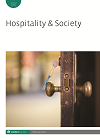
Full text loading...
 , Emma Martin1
, Emma Martin1
Business-owning parents face the decision of whether to involve their own children in the family business. Employing family members for little or no wages is widely documented in the hospitality and tourism industries, though children’s role in such businesses is often missing from the literature. This article seeks to address this gap by exploring parental motives for involving children in the family business and the impact of such decisions on parent–child relationships in later life. The article adopts a multi-generational approach, comparing both parent’s and children’s accounts of adolescent work performed at the family business. The research findings are based on semi-structured interviews with nineteen individuals across five restaurant-owning families. The article concludes that parental motives for adolescent work are a composition of convenience, economic gain and an attempt to educate the next generation. We further argue that adolescent work serves as an ‘imprinting’ mechanism and demonstrate that children perceive their family business involvement to be a purely economic endeavour when their parents neglect to practise imprinting. The research findings indicate that when this happens, offspring recall their adolescent work experience negatively and it is detrimental to parent–child relationships. The originality of the article stems from the research findings which are based on interviews among adults who recalled their past experiences of adolescent work, thus allowing the longer lasting impact of adolescent work on parent–child relationships to be explored, whereas previous work adopting a similar focus has been conducted among adolescents.

Article metrics loading...

Full text loading...
References


Data & Media loading...

Publication Date:
https://doi.org/10.1386/hosp_00058_1 Published content will be available immediately after check-out or when it is released in case of a pre-order. Please make sure to be logged in to see all available purchase options.